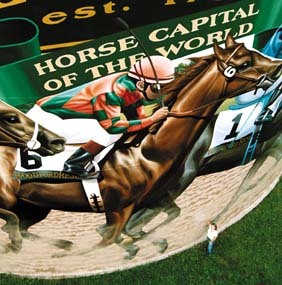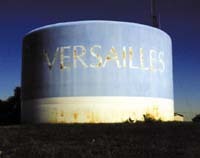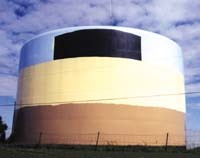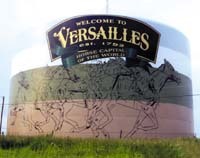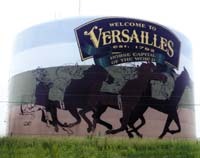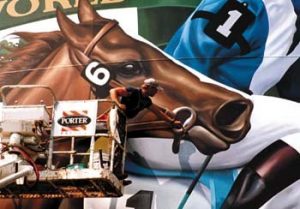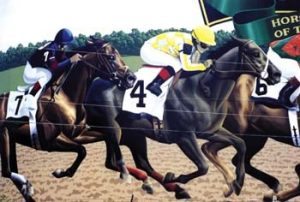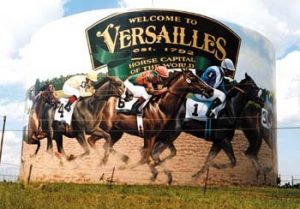This project arose from a conversation with Fred Siegelman, the mayor of Versailles, KY, a town of 8,600 located in Woodford County, which is home to just over 17,000 people — and approximately 20,000 horses. A few years ago, Siegelman was talking to Jamie Gay, an old friend and mayor of Danville, KY.
Gay wondered how many people driving past Versailles’ aging, rusty water tower — with its chipping, blue paint and faded, peeling lettering — thought to themselves, "I bet Versailles used to be a nice place to live." Even a water tank on the outskirts of town gives an impression of the city’s quality of life.
Siegelman recalled admiring a mural painted on the Kentucky American Water Co.’s tank at the junction of Interstates 64 and 75 near Lexington. He learned that I’d painted that structure and contacted me.
Fortunately, financing the project wasn’t an obstacle; moreover, it didn’t cost Versailles tax payers one thin dime. Siegelman single-handedly raised the money with contributions from eight horse farms and other local businesses, including Versailles-based Ruggles Sign Co., which generously allowed us to incorporate the City of Versailles logo they’d designed into the mural.
Several of the 63,000 motorists who passed by daily on the Bluegrass Parkway enlivened my daylight work with honks and occasional cheers; nighttime work, done under a spotlight, was generally quieter and more subdued, save an encounter with some baby skunks that nested under my paint palette.
Into the gate
Few artists deal with more natural hazards than an outdoor painter. The weather report is as much a tool as my paint or sprayer. Wind is always a concern, because it can cause a 60-ft. boom lift — which I commonly use — to become unstable, but also because it causes paint to spatter.
Incessant rain derailed the project for the entire month of May. Not only did this impact my work, but the frequent halts and starts took me out of my rhythm.
Before beginning the project, I studied equine anatomy. With so many horse farms in such close proximity, I needed to distinguish between thoroughbreds, Arabians, quarter horses and others. For instance, I noticed that thoroughbreds’ musculature is leaner than most other horses’. Further, their nostrils flare into large ovals when at a dead run.
When researching the race scene, I reviewed photographs of horses in numerous strides to capture the authentic experience of a race in progress. However, I crafted a scene without a beginning or end; numerous horse farms had contributed substantial money to this project, so I didn’t want to appear to glorify a winner from a certain stable. I consider it diplomacy.
Working on a 47-ft.-tall, 2-million-gallon tank, I appeared to be roughly the size of a jockey’s crop compared to my painting. I never use a grid to chart a scene; creating the grid itself takes longer than filling it in, so I view it as a waste of time.
For this job, I created a scale model by blowing up black-and-white photos and creating paste-ups. At night, I used a 3M projector to shoot the scene onto the tank’s surface.
Down the stretch
Using 18- and 9-in.-wide rollers, I applied two, solid basecoats of Porter direct-to-metal (DTM) acrylic paint onto the 12,722-sq.-ft. tank. This type of paint is specially formulated for such exterior structures. I’ve tried working with epoxies, but they dry too quickly for such large jobs, and they’re usually suitable only for basic logos. Further, DTM colors last longer, because they contain crushed pigment rather than liquid, and, because they contain a UV protectant, they require no clearcoat.
Using two coats, I scaled out the signage at the top and began outlining a configuration. To sketch three-story-high thoroughbreds, I used wax pencils to create figure outlines, and then painted within the lines.
Next came the job’s most time-consuming part — blocking in the paint and mixing hundreds of colors to blend layers of detail. I blended them on my palette, which is pretty taxing when you’re on your feet 12 to 15 hours a day, six days a week. At this point, I held two, 4-in-wide brushes in each hand to alternate the colors, which accentuate such details as the horses’ muscles, and the silhouettes and creases in the jockeys’ silks. I always tried to work on the shady part of the tank.
Finally, I used a Titan 447 airless sprayer to create "dust" kicking under the horses’ hoofs. I paletted a hue three shades lighter than the dirt’s color and rolled my wrists to create the impression of dirt projecting in all directions. I increased the sprayer’s psi to 2,300, and used a 17-in.-long tip, the longest Titan offers.
I do most of my painting by hand or with rollers. It’s a skill I’ve developed, because I perform a sizeable portion of my work on tanks within oil refineries, where they don’t want pressurized air near petroleum products.
Winners’ circle
After 75 days, I’d completed the tank. Siegelman told me that out-of-state travelers traversing the Bluegrass Parkway have stopped to admire the tank. Further, Versailles city officials and I have received numerous, complimentary letters. I think it’s a nice change of pace from the billboards that typically dot roadways.
For a unique look at the creation of this project, visit www.versailleswatertank.com. The Website features a three-minute, time-lapse video recounting how I decorated the tank.
Henn and Siegelman would like to thank the following horse farms and organizations for their generous contributions: Adena Springs Farm, Airdrie Stud Farm, Ashford Stud Farm, Fawn Leap Farm, Gainsborough Farm, Lane’s End Farm, Win Star Farm and the Kentucky Thoroughbred Assn.
Equipment and Materials
Paint: Porter DTM paint (formulation like enamel), available from any paint store.
Brushes: China bristle brushes, stain brushes and rollers, from Harbor Freight (Camarillo, CA), (800) 423-2567; Titan 447 airless sprayer, from Titan Tool Inc. (Franklin Lakes, NJ), (800) 526-5362.
Lift: Sixty-ft. boom lift, rented from Versailles Rent-All (Versailles, KY), (606) 873-3924.
Projector: 3M
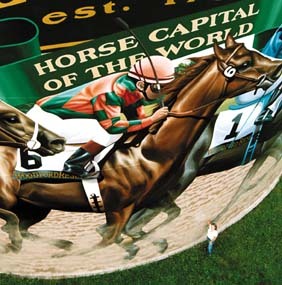


 Photo Gallery2 weeks ago
Photo Gallery2 weeks ago
 Paula Fargo2 weeks ago
Paula Fargo2 weeks ago
 Real Deal1 week ago
Real Deal1 week ago
 Photo Gallery2 weeks ago
Photo Gallery2 weeks ago
 Projects1 week ago
Projects1 week ago
 Women in Signs2 weeks ago
Women in Signs2 weeks ago
 Signs of the Times2 weeks ago
Signs of the Times2 weeks ago
 Business Management7 days ago
Business Management7 days ago